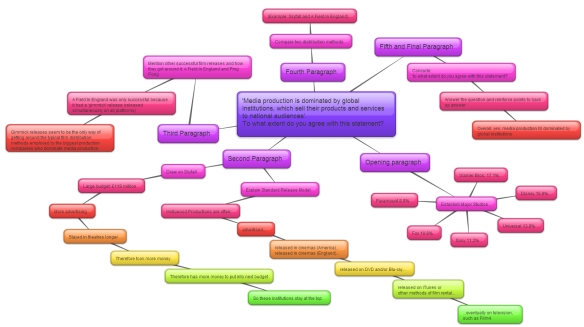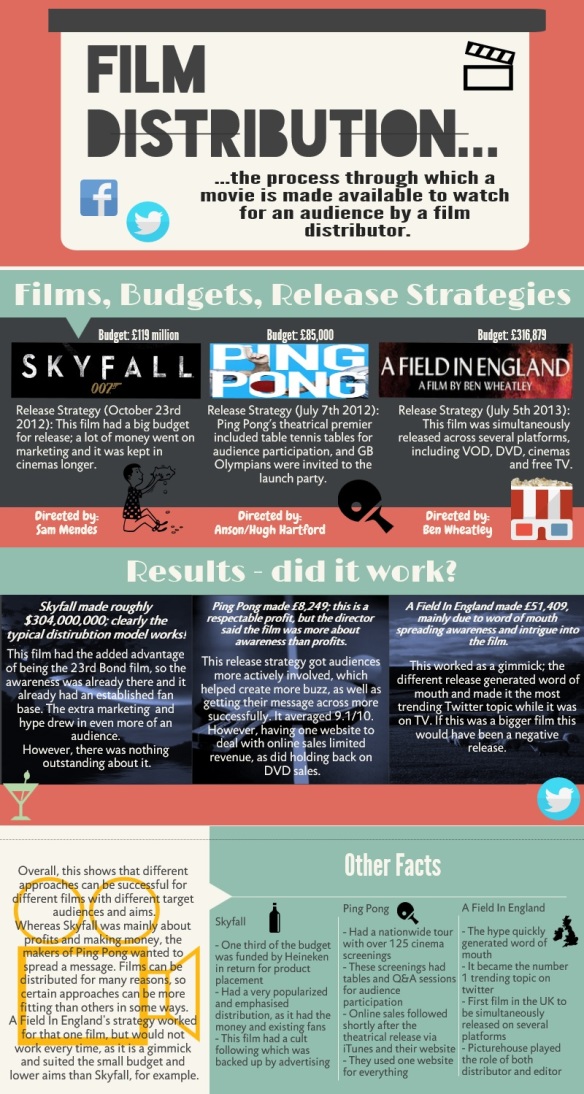‘Media production is dominated by global institutions, which sell their products and services to national audiences’.
To what extent do you agree with this statement?
Tag Archives: Film Distribution
Film Distribution Infographic
Film Distribution
How was ‘A Field In England’ launched and why did it work?
The film ‘A Field In England’, was released  simultaneously across all platforms, including VOD (video on demand, such as iTunes, BT Vision and Sky on Demand), DVD and BluRay, cinema, and free broadcast TV (such as Film4). This was a first for an independent, low-budget film; director Ben Wheatley tried to break the typical Hollywood model of distribution by becoming the first film in the UK to launch across every platform on the same day.
simultaneously across all platforms, including VOD (video on demand, such as iTunes, BT Vision and Sky on Demand), DVD and BluRay, cinema, and free broadcast TV (such as Film4). This was a first for an independent, low-budget film; director Ben Wheatley tried to break the typical Hollywood model of distribution by becoming the first film in the UK to launch across every platform on the same day.
Big Hollywood ‘tentpole’ films usually have staggered release windows across various platforms, which can often take months – for example, a new big Hollywood film will first come out as teasers and trailers, then in the cinema for a couple of months, then a while after it will be released on DVD, then it will soon be released as VOD, such as iTunes, and then film providers such as LoveFilm, and then perhaps a few years later it will be shown on TV. These staggered releases can build anticipation, and certainly help to bring in money – it gives people the  opportunity to hear about it by word of mouth, and for the hype to finally get to them. ‘Tentpole’ franchises are so called because they bring in a lot of money, and can therefore ‘hold up’ the companies. On the downside, creating a lot of anticipation for a film can also lead to an increase in illegal downloads, which is why most films are now released simultaneously in America and England.
opportunity to hear about it by word of mouth, and for the hype to finally get to them. ‘Tentpole’ franchises are so called because they bring in a lot of money, and can therefore ‘hold up’ the companies. On the downside, creating a lot of anticipation for a film can also lead to an increase in illegal downloads, which is why most films are now released simultaneously in America and England.
With a low-budget film like ‘A Field In England’, however, it does not have the money to create as much anticipation around the film, and so launching it on several platforms was worthwhile. The stunt made the film the number one trending topic on Twitter for a couple of hours, which also brought more attention to it, along with the media picking up on the gimmick.
Each platform has its advantages and disadvantages:
- Video On Demand (iTunes, BT Vision and other rentals): It’s instant and convenient – you don’t have to leave the house, and with connected TV, you don’t even have to leave the sofa. However, rentals can be expensive for just 48 hours, and the quality is only as good as the device you’re watching it on.
- Free broadcast TV (Film4): It’s free (obviously), you don’t have to leave the house, and it can be recorded and paused (with the right type of television equipment). However, the quality could be bad, the film could be interrupted by adverts, it could be subject to censorship if it’s shown before nine, and it would only be shown once or twice on Film4 and Film4+1, which means you could easily miss it.
 Cinema: Many people believe the cinema experience is worth paying eight or nine pounds for, particularly for the atmosphere, the inclusion with the audience, and for the 3D effects, better sound and visuals, and IMAX, all of which cannot be replicated at home, and so adds value. However, it’s more expensive and more effort than it would be to watch it at home. There’s also a limited time window in which you can watch it at a cinema before it’s replaced, and you cannot pick and choose when you watch it.
Cinema: Many people believe the cinema experience is worth paying eight or nine pounds for, particularly for the atmosphere, the inclusion with the audience, and for the 3D effects, better sound and visuals, and IMAX, all of which cannot be replicated at home, and so adds value. However, it’s more expensive and more effort than it would be to watch it at home. There’s also a limited time window in which you can watch it at a cinema before it’s replaced, and you cannot pick and choose when you watch it.- Physical Retail (ie, DVD/BluRay): You get to choose when and where to watch the film, and you can watch it as many times as you like, as well as watching special features such as a director’s cut. Things like subtitles and audio description can also add value to a certain market. However, not many people would actually watch a film more than once and so it can therefore end up being quite costly.
Digital Democratisation:
“‘Digital Democratisation’ is the idea that digital technologies will disrupt the hegemony of the media industries, enabling the public to produce and distribute their own content and have a greater freedom of access to content”.
Pop-Up Cinemas:
Pop-up cinemas are another way of adding value to a film; they can be used as an opportunity to screen films which might otherwise find it difficult to get distribution because they’re too specialist, unknown, or low-budget. They usually take place in unusual locations which would otherwise remain unused, and is kind of a way of ‘urban recycling’… These locations can be tailored specifically to a film, including looking like a certain place or setting, inviting the audience to dress up or do certain things, and by getting involved with like-minded local organisations to provide interesting snacks and drinks.
Examples include things such as a desert locations, complete with camels, for a screening of ‘Lawrence of Arabia’; a ‘Back to the Future’ trilogy aimed at nostalgic fathers; and a properly vintage cinema experience.
The uniqueness of the event is what really adds value to the film; even if the film wasn’t quite as good as you expected it, simply being part of the experience could be good enough in itself, which is really what draws crowds and subsequently draws money.




